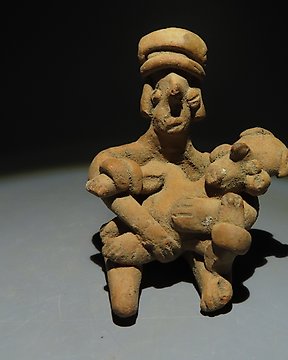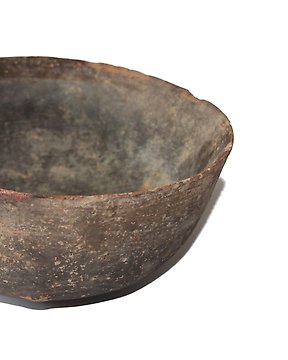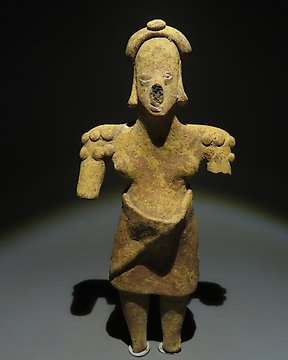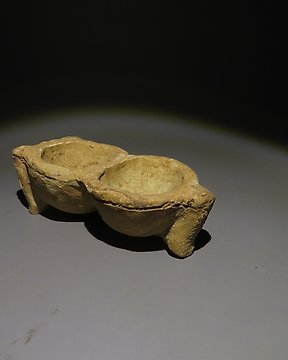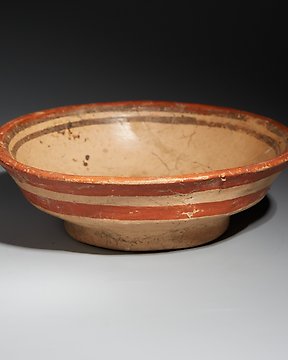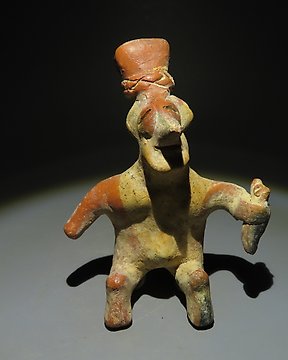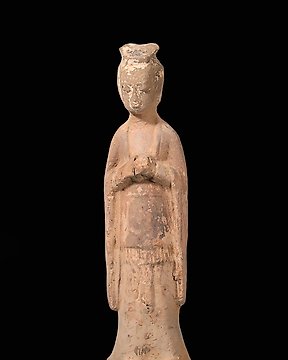All OK and with very fast shipping.
Zobacz tłumaczenieStarożytne Chiny Terakota Głowa wojownika Stickman. Dynastia Han, 206 p.n.e.-220 n.e. Wysokość 12cm.
Nr 84916133
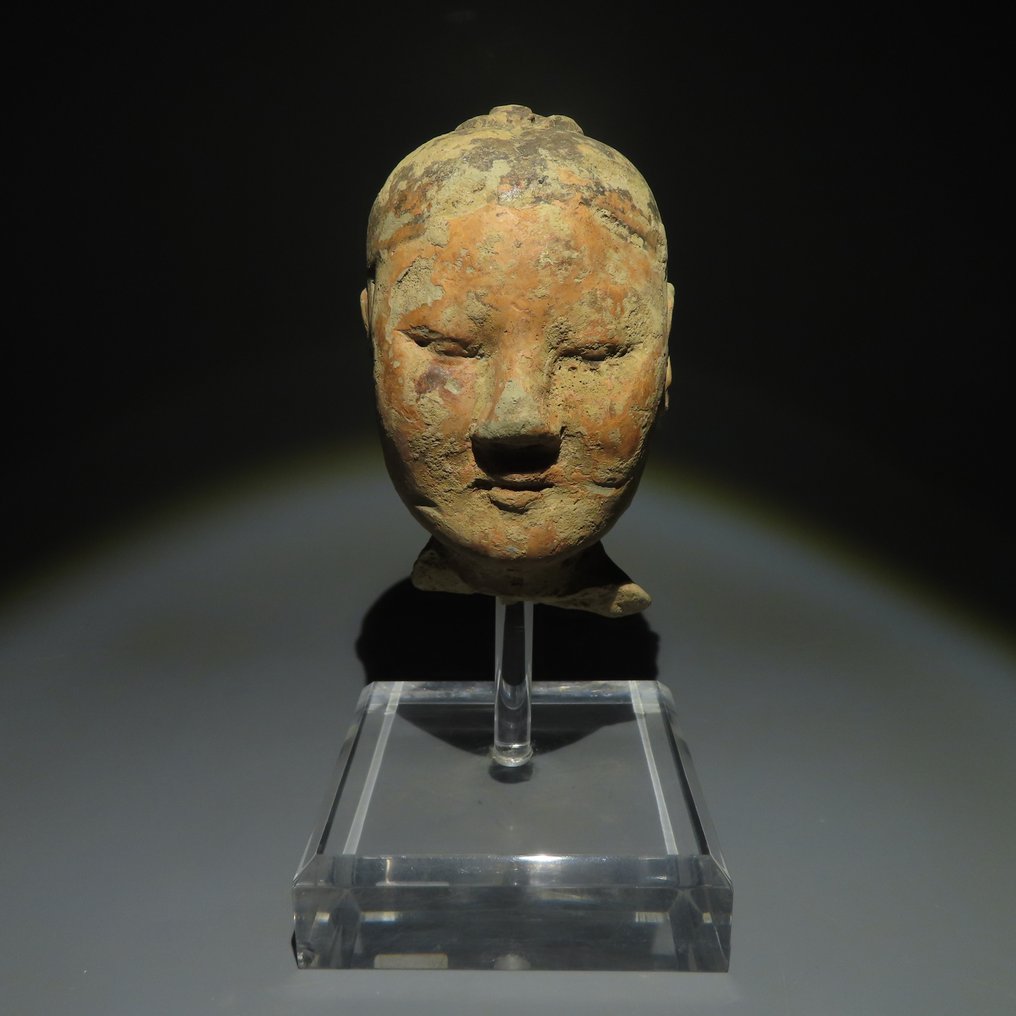

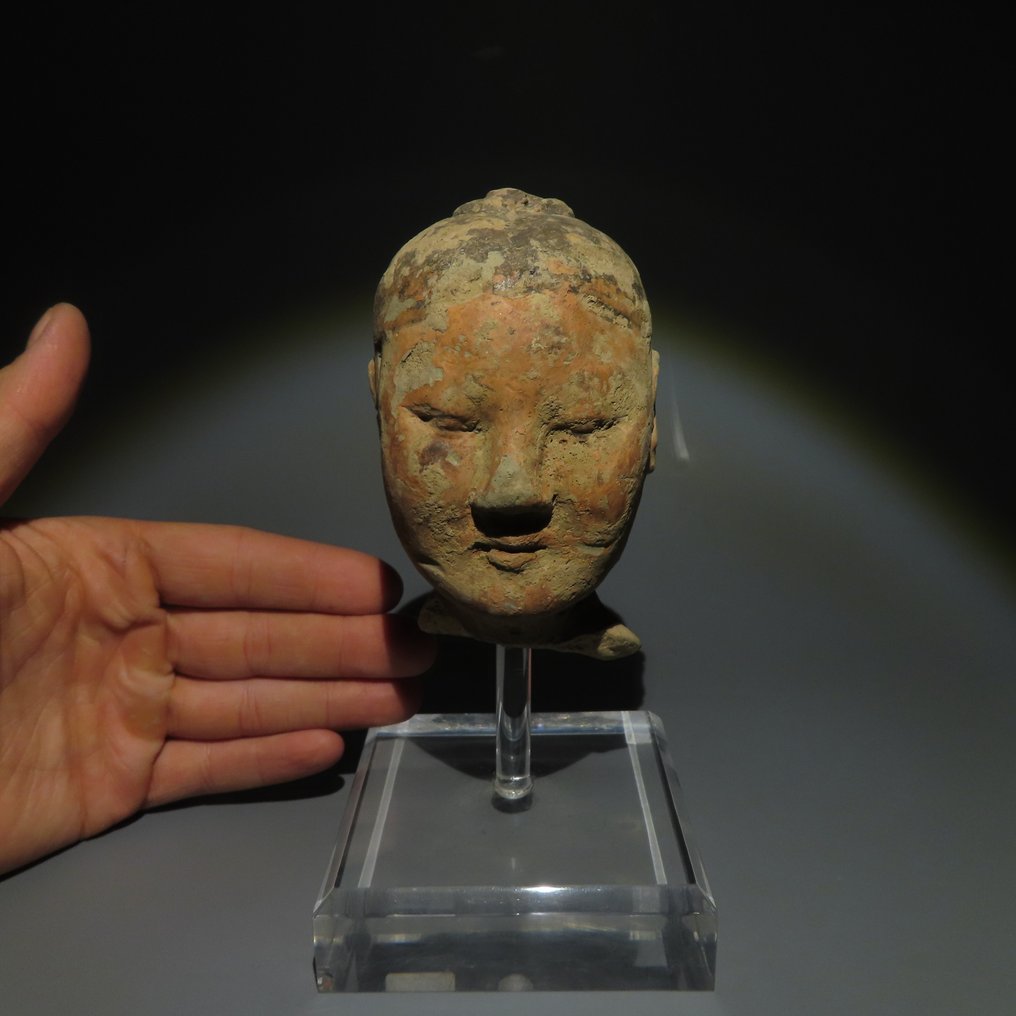
Head of a Stickman Warrior.
Ancient Chinese
Han Dynasty, Circa 206 BC - 220 AD.
Terracotta
12 cm height and 17.5 cm height with the stand
PROVENANCE: Gerpin private collection, Belgium. 1970
CONDITION: Good condition.
DESCRIPTION:
The Stickman figures were only used by the royal family and where placed like armies to help and protect the owner in the afterlife.
The art of the Han dynasty (206 BCE - 220 CE) of ancient China is characterised by a new desire to represent everyday life and the stories from history and mythology familiar to all. The arts were fuelled both by a political stability with its consequent economic prosperity and the development and highly successful combination of brushes, ink, and paper. Calligraphy, painting, lacquerware production, and jade carving were just some of the areas Han artists pushed forward the boundaries of what was possible to make technically and what was desired aesthetically by the ever-increasing number of art connoisseurs.
Large figure sculptures are rare from the Han period, but there are some statues representing generals and officials which were stood outside their tombs. Smaller-scale works include cast bronze sculptures of horses which are common in 2nd-century CE Han tombs. These are usually depicted in full gallop with only one hoof resting on the base so that they almost appear to be flying.
Painted earthenware figurines of single standing women, men, and servants are common. Cast bronze was used to make small figurines and ornate incense burners. These were often inlaid with gold and silver or gilded. One superb piece is a gilded bronze oil-lamp in the form of a kneeling servant girl, which dates to the late 2nd century BCE.
Jade was especially esteemed for its rarity, durability, purity, and certain mystical qualities. The material was carved into all manner of animals, people, and mythical creatures. Han Jade carvers now used circular cutting drills and iron tools, but pieces often have a lower quality finish than previously, which suggests they were starting to be made quicker and on a larger scale of production. Another feature of Han jade sculpture is the use of flaws and impurities in the jade to make them part of the sculpture. From the 1st century BCE, a pure white jade became available from central Asia following the expansion of the Han empire.
One unique but stunning art form was the creation of jade 'suits' to cover the body of the deceased in royal tombs. The 'suits' cover the contours of the body and are made from up to two thousand individually carved rectangular pieces of jade stitched together using gold or silver wire. Two outstanding examples come from the late 2nd century BCE tomb of Prince Liu Sheng and Princess Dou Wan at Mancheng. Reserved only for royalty, they nevertheless became so costly to produce that later rulers banned their use.
Notes:
- The piece includes authenticity certificate.
- The piece includes Spanish Export License.
- The seller guarantees that he acquired this piece according to all national and international laws related to the ownership of cultural property. Provenance statement seen by Catawiki.
#printemps
Historie sprzedawców
Head of a Stickman Warrior.
Ancient Chinese
Han Dynasty, Circa 206 BC - 220 AD.
Terracotta
12 cm height and 17.5 cm height with the stand
PROVENANCE: Gerpin private collection, Belgium. 1970
CONDITION: Good condition.
DESCRIPTION:
The Stickman figures were only used by the royal family and where placed like armies to help and protect the owner in the afterlife.
The art of the Han dynasty (206 BCE - 220 CE) of ancient China is characterised by a new desire to represent everyday life and the stories from history and mythology familiar to all. The arts were fuelled both by a political stability with its consequent economic prosperity and the development and highly successful combination of brushes, ink, and paper. Calligraphy, painting, lacquerware production, and jade carving were just some of the areas Han artists pushed forward the boundaries of what was possible to make technically and what was desired aesthetically by the ever-increasing number of art connoisseurs.
Large figure sculptures are rare from the Han period, but there are some statues representing generals and officials which were stood outside their tombs. Smaller-scale works include cast bronze sculptures of horses which are common in 2nd-century CE Han tombs. These are usually depicted in full gallop with only one hoof resting on the base so that they almost appear to be flying.
Painted earthenware figurines of single standing women, men, and servants are common. Cast bronze was used to make small figurines and ornate incense burners. These were often inlaid with gold and silver or gilded. One superb piece is a gilded bronze oil-lamp in the form of a kneeling servant girl, which dates to the late 2nd century BCE.
Jade was especially esteemed for its rarity, durability, purity, and certain mystical qualities. The material was carved into all manner of animals, people, and mythical creatures. Han Jade carvers now used circular cutting drills and iron tools, but pieces often have a lower quality finish than previously, which suggests they were starting to be made quicker and on a larger scale of production. Another feature of Han jade sculpture is the use of flaws and impurities in the jade to make them part of the sculpture. From the 1st century BCE, a pure white jade became available from central Asia following the expansion of the Han empire.
One unique but stunning art form was the creation of jade 'suits' to cover the body of the deceased in royal tombs. The 'suits' cover the contours of the body and are made from up to two thousand individually carved rectangular pieces of jade stitched together using gold or silver wire. Two outstanding examples come from the late 2nd century BCE tomb of Prince Liu Sheng and Princess Dou Wan at Mancheng. Reserved only for royalty, they nevertheless became so costly to produce that later rulers banned their use.
Notes:
- The piece includes authenticity certificate.
- The piece includes Spanish Export License.
- The seller guarantees that he acquired this piece according to all national and international laws related to the ownership of cultural property. Provenance statement seen by Catawiki.
#printemps
Historie sprzedawców
- 744
- 6
- 0
Prachtig schilderij. Zo blij mee. Zeer nette verkoper en zeer snelle levering.
Zobacz tłumaczenieperfect ! very fast and high quality delivery !
Zobacz tłumaczenieAll well! Thanks.
Zobacz tłumaczenieVendeur très professionnel, top +++×
Zobacz tłumaczeniePhotos trop contrastées pour bien percevoir les défauts, mais ces défauts étaient visibles pour autant. Le "Bon état" est trompeur. Sinon, envoi rapide et correctement emballé. Frais de port exagérés.
Zobacz tłumaczenieGreat communication, delivery and product. Came with a well made certificate of authenticity and good packaging. Overall very happy with the purchase! Delivery is a bit expensive, but I recommend it
Zobacz tłumaczenieMagnifique témoin du passé, envoyé avec tous les justificatifs, impeccable. Encore une fois très satisfait, un grand merci
Zobacz tłumaczenieThank you for the Special offer and the fast shipping of this excellent piece of art!
Zobacz tłumaczenievery good description of the object, very good price for this rare item,. Fast sending (has been at my place 2 days after buying!). Definitely would buy again.
Zobacz tłumaczenieSehr schön
Zobacz tłumaczenieAs described, perfect logistic
Zobacz tłumaczeniegreat seller, everything came as should with certificate of authenticity
Zobacz tłumaczenieExceptionally well packaged, description aligned with positing received
Zobacz tłumaczenieReally precious, but without sound...
Zobacz tłumaczeniePainting well packed and rapidly sent!
Zobacz tłumaczeniesempre grande rapidità e professionalità
Zobacz tłumaczenieparfait bien reçu, merci
Zobacz tłumaczenieVery satisfied with the small Greek Lekythos. As always (we have already bought several items from Bagot), the object was wrapped and sent immediately and with the greatest care.
Zobacz tłumaczeniePerfect, excellent condition, good packaging, the parcel arrived without any problems… all is perfect as usual. Thank you very much and wait for an other nice piece like this one. Gilles.
Zobacz tłumaczenie+++ Top vendeur professionnel comme d'habitude
Zobacz tłumaczenieEmbora o custo de transporte esteja acima da média foi, realmente, muito bem executado e em embalagem cuidada. Expeditos e profissionais. Recomendo
Zobacz tłumaczenieSnel en correct en goed verpakt verzonden
Zobacz tłumaczenieoggetto bellissimo, fedele alla descrizione, venditore affidabile
Zobacz tłumaczenieVery nice piece and fast delivery
Zobacz tłumaczenie- 744
- 6
- 0
All OK and with very fast shipping.
Zobacz tłumaczenieKlauzula
Sprzedawca gwarantuje i może udowodnić, że przedmiot został nabyty legalnie. Sprzedawca został poinformowany przez firmę Catawiki, że musi dostarczyć dokumentację wymaganą przez przepisy ustawowe i wykonawcze obowiązujące w jego kraju zamieszkania. Sprzedawca gwarantuje i jest uprawniony do sprzedaży/eksportu tego przedmiotu. Sprzedawca przekaże nabywcy wszystkie znane informacje o pochodzeniu przedmiotu. Sprzedawca zapewnia, że wszelkie niezbędne pozwolenia są/zostaną załatwione. Sprzedawca niezwłocznie poinformuje nabywcę o wszelkich opóźnieniach w uzyskaniu takich zezwoleń.
Sprzedawca gwarantuje i może udowodnić, że przedmiot został nabyty legalnie. Sprzedawca został poinformowany przez firmę Catawiki, że musi dostarczyć dokumentację wymaganą przez przepisy ustawowe i wykonawcze obowiązujące w jego kraju zamieszkania. Sprzedawca gwarantuje i jest uprawniony do sprzedaży/eksportu tego przedmiotu. Sprzedawca przekaże nabywcy wszystkie znane informacje o pochodzeniu przedmiotu. Sprzedawca zapewnia, że wszelkie niezbędne pozwolenia są/zostaną załatwione. Sprzedawca niezwłocznie poinformuje nabywcę o wszelkich opóźnieniach w uzyskaniu takich zezwoleń.
